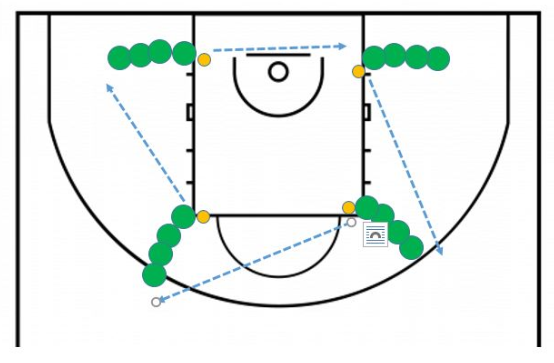Basketball drills
- The teacher sets out three areas of approximately equal size with pawns.
- It is best to use the volleyball lines (see map).
- There are three sections (see map):
- Left: barons square (losers square)
- Middle: princes section (neutral section)
- Right: king of the court (winner section)
- All students stand in the middle section.
- With a signal from the teacher the game starts.
- All pupils have to try to tap/strike the ball of another pupil out of the box.
- If you succeed you move one square to the right.
- If your ball is knocked away you move up one square to the left.
- If you hit/tap someone's ball out of the box on the right you score a point.
- If your ball is knocked out of the winner's box you lose all your points.
- If your ball is knocked out of the left box nothing happens and you stay standing.
- When the teacher gives the final signal the person with the most points is king of the court and he/she has won.
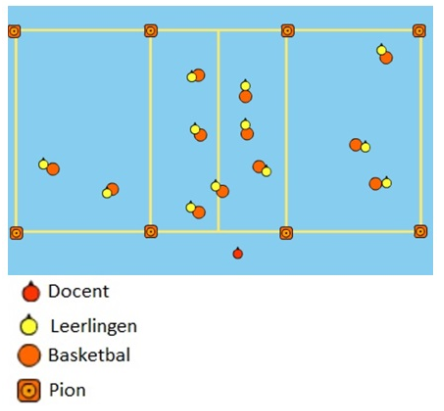
- The teacher chooses 2 tickers.
- They have to stay inside their box (inside the 4 pawns) and knock the basketballs away from the runners when they want to cross.
- The runners have to dribble to the other side without losing their basketball.
- If a runner doesn't have his basketball with him, he's out and he automatically becomes a ticker.
- A tip that you can give to the runners is that they should shield the ball with their body.
- This means staying between the ball and the opponent.
- The pupils may only cross again when everyone has been tagged or has reached the other side.
- In the end, as the game progresses, you get more and more tickers and less and less runners.
- The last remaining runner is the winner.
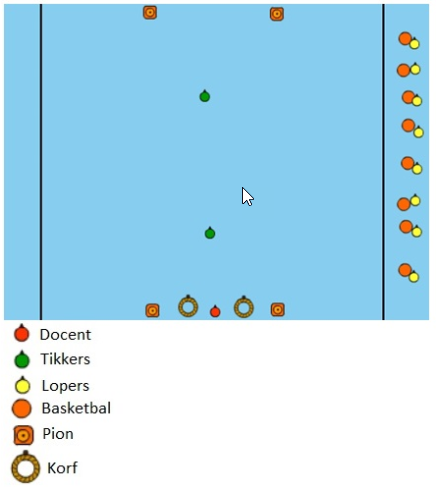
- The players stand around the bucket or on the free throw line and try to score in the basket.
- Vary their position and distance.
- Players dribble from the center line to the free throw line and try to score from there within 5 seconds.
- Two players throw the ball to each other, the ball may bounce.
- To make it more difficult the bouncing can be omitted.
- Also vary the distance.
- The players stand in a circle and throw the ball to each other.
- They are not allowed to touch the ground.
- Try this with a player in the middle who is trying to intercept.
- If the ball is intercepted, the player who threw the ball stands in the middle.
- The players bounce the ball on the spot.
- Make sure the hand is always on the ball so the ball is pushed down (so not hit down).
- The players sink through their knees so they are low to the ground and the ball bounces faster.
- Then the players stretch their knees again. Repeat several times.
- The players dribble through each other, changing direction all the time so that they are criss-crossing each other.
- The players must try not to touch each other.
- The players try to guide the ball along a route whilst dribbling.
- For example slalom around cones or over benches (at your own discretion).
- Divide the players into two groups.
- The group without the ball tries to tap the player in the other group with the ball.
- As soon as they have touched the player with the ball, the ball is theirs.
- The player with the ball therefore tries to pass the ball on to a teammate as quickly as possible.
- Touching someone with a ball gives a point. The team that scores ten points first wins.
- They are simple but fun basketball games for children with a number of advantages:
- The children get more ball feeling
- The children learn how to aim the basketball
- The children learn to dribble well
- The children develop team spirit and learn to work together
- The children move in the indoor gym or on the outdoor sports field
Ideal for training, lessons and fun activities.
- Set up a course with running boards, bridges, hoops and cones and have the kids dribble down the course.
- You can make it as difficult as you like. The child who completes the course in the shortest time wins.
- The children stand in a large circle.
- There are several basketballs in the game.
- The children with the ball bounce the ball as fast as possible to a classmate or group member, while calling his or her name.
- This is recommended for children's camps (great outdoors!) or sports days, where children can learn each other's names and learn to catch the ball.
- Players who do not bounce the ball well, do not catch the ball or call out the wrong name, step out of the circle and do not participate for a while.
- As fewer and fewer players remain, the remaining players bounce more and more balls.
- Continue, until only one or two players remain.
- They have won.
- Place a row of cones and give each child its own basketball.
- The children are challenged to dribble around the cones.
- They are not allowed to hit the cones and they are not allowed to lose their ball.
- The children follow each other quietly. The pace is gradually increased.
- When the children get more ball control, put another row of cones parallel to the first row.
- Let the children play a game: the first one who manages to dribble around the cones without a fault has won.
- Let the winners play against each other, until only one winner remains.
- A good basketball exercise for more ball control.
- Half of the basketball players have a ball.
- These basketball players dribble all over the room.
- On the whistle they pass the ball to someone they first made eye contact with.
- The pass they use to do so is up to them.
- Choose the pass that is best in the situation.
- If you are close to the ball, do not pass.
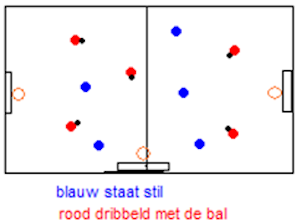
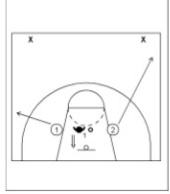
- Centers + Guards + Forwards
- 3 Players
- 1 ball
- -a basket
- -2 Cones
Requirements :
Players must be able to dribble and run a layup
Goal :
- To finish off an overtime situation in 2-man break.
- train outlet pass
- to train running line flyer
Organization:
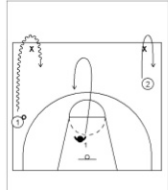
- the defender throws the ball against the board, left or right of the ring
- the attacker on the side of the board takes the outlet position and asks for the ball.
- The flyer sprints away towards the middle line.
- Flyer sprints around the pawn back to the basket.
- outlet dribbles as fast as possible around the other pawn
- the passer sprints to the centre circle, but has 1 foot in there and then goes to defend.
- attackers have 1 goal attempt and max 2 passes.
- the attacker who misses becomes the defender.
Teaching points
- the defender NOT to make any unsportsmanlike mistakes
- defender takes the charge or forces the dribbler to the side of the pitch
This drill will help develop proper passing and shooting techniques. This drill also emphasizes communication between teammates
- Divide the team into four squads. One team on each block and one team on each elbow. Give each team one ball.
- The first person in each line shoots and follows his shot, passing it back to the next person in his line.
- After rebounding the ball, the shooter returns the ball to the line they were in and rotates clockwise to the end of the next spot. Rotations are shown in the diagram.
- All four lines work as a team and keep track of the total number of shots scored.
- Emphasize to the players that communication is very important in this drill.
- Players must make game-winning passes and their shots must also be taken at game level.
- The time limit of this exercise can be changed from five minutes to whatever you like or number of shots scored
- Also the spots on the court where the players shoot from can be varied
